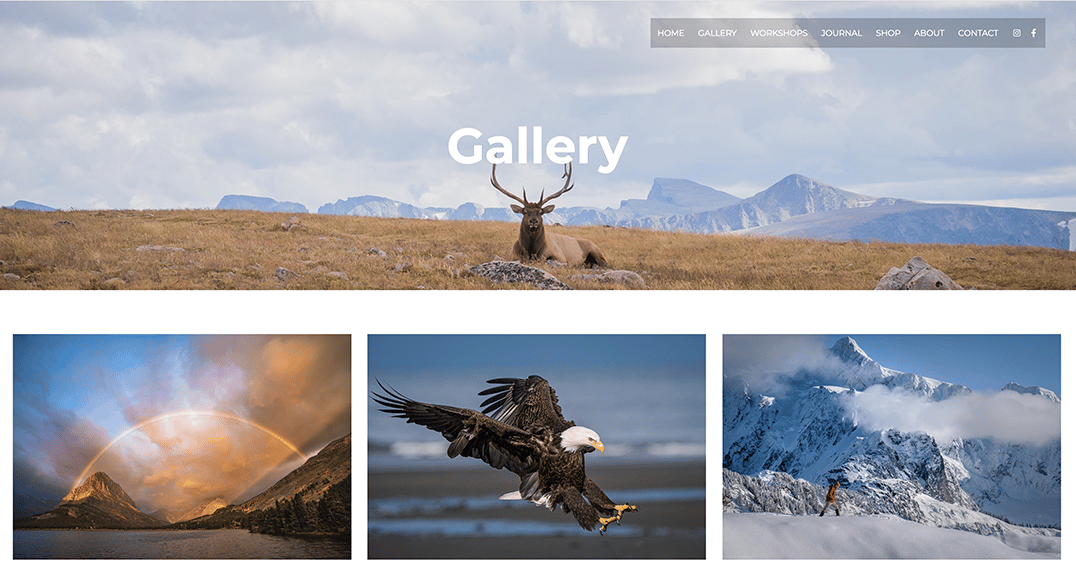
How to make a photography portfolio
Thinking about turning your passion for photography into a business? Check out our free guide on how to make a Photography Portfolio, including 15 pro tips.
Thinking about turning your passion for photography into a business? Maybe you’ve got a few gigs under your belt and are eager for more, or perhaps you’re starting from scratch in the world of making money as a photographer.
Either way, one of the first things you’ll need to do to grow your clientele is to learn how to make a photography portfolio.

Beauitfully designed website themes and online portfolios for photographers.
Save 25% by using code SHOTKIT25
Having an online portfolio (and perhaps even one in print) that showcases your best work is one of the primary ways prospective clients can judge for themselves whether they want to work with you.
The following article has everything you need to know for creating a photo portfolio from the ground up. It’ll also have some key tips for improving existing portfolios.
Let’s take a look.
What Should a Photography Portfolio Include?
Photography portfolios don’t have to be complicated, but there are a few things you’ll need to make it easy for prospective clients to choose you:
- A curated selection of your best photos
Actually, you need to pick the best of your best shots. According to one recent study, potential clients may take as little as six seconds to decide whether or not they want to work with you. That means they may only see a tiny portion of your photos, making it crucial that you include only your absolute best work.
Dovetailing off of this, it’s also important to avoid the temptation to include lots and lots of photos. Anywhere between 12 to 20 photos is just about right. You can even go up to 30 images, but any more than this can become a bit tedious for the viewer.
Here’s how to curate photos.
- A compelling About Me page
The About Me page will probably be your most visited page on your photography portfolio. As a result, it needs to be particularly strong. This is your chance to introduce yourself and your brand.
The more personable and authentic your photographer bio is, the easier it will be for prospective clients to feel like they can connect with you.
As far as the various elements to include on your About Me page, start by introducing yourself with your name, what kind of photography you shoot, and where you’re based.
From here you can go on to talk about your experience, any awards you’ve won, your inspirations, or anything else you think your clients would like to know. Just be careful not to make it too long: about 2-4 paragraphs is about right.
If you don’t have a separate Contact page, this would also be the place for your contact information and any social media links you’d like to include. It’s also a good place to list any past clients you’ve had to add legitimacy to your budding business.
See more on how to write a photographer bio.
- Pricing/Rate page
Figuring out pricing can be one of the more challenging parts of starting up a photography business, but even if you’re not sure of what you should charge giving your prospective clients some idea of your rates is important.
Why? You want to make it as easy as possible for a potential client to choose you, and many visitors to your site won’t want to take the added time to call or email about your prices. If they contact you after looking at your pricing page, they’re likely ok with your rates.
How Do I Make a Free Photography Portfolio?

A well-curated photography portfolio showcasing the work of Jen Huang Bogan
It’s actually relatively easy to create a free photography portfolio, though it will entail a bit of work to make it the best it can be.
Here are the steps you’ll need to take:
1. Create an account with a free website builder or a portfolio website.
For a great photography portfolio website, it’s best to go with one that’s specific to photography.
How Much Do You REALLY Know About Photography?! 🤔
Test your photography knowledge with this quick quiz!
See how much you really know about photography...

For example, Adobe’s Behance is one of the most widely-used digital photography portfolio sites online. It caters to a wide variety of creative professionals, not just photographers, and a number of recruiters looking for new talent regularly peruse the site. It’s also easy to use, allows others to leave feedback, and easily links to your social media accounts.
There’s also Adobe’s very own product ‘Portfolio’, which offers a free way to host, display and manage your images using attractive themes and Adobe Portfolio templates.
Crevado is another popular free photo portfolio site. It uses drag-and-drop technology for uploading and arranging your digital photography, as well as being optimized for all devices. Your portfolio will look just as good on a smartphone or tablet as it will on a desktop.
Another excellent option for showcasing your photography portfolio is the site YouPic. YouPic has a number of pricing options, but their free one includes a portfolio, stats, e-commence, and the opportunity to get global exposure. It also happens to be the first decentralized photography platform, allowing you to copyright your photos on a blockchain and keep all your rights reserved.
Like YouPic, there are a number of other photography curation sites out there that include an online portfolio option with membership (free and otherwise). If you’re already on sites like 500px and Viewbug, you may want to take a look at their photo portfolio options. Most come with e-commerce options too.
If you’re looking to create an entire website for your photography business, a website builder like Appypie, Wix, WordPress, or Koken might be your best option. Creating a portfolio website from scratch will take a bit more time investment, but they’re well worth the investment if you want a full suite of services are willing to build it yourself. (Note: you’ll need your own domain for WordPress and Koken, but if you’re serious about growing your brand this is a good thing.)
2. Pick a template
Once you decide on the platform, you’ll need to pick a template. (In WordPress this would be called a “theme.”) Templates will determine the layout and color scheme of your photography portfolio, as well as your page organization.
Some sites have 6-7 to choose from. Others, like WordPress and Wix, have hundreds to choose from. See our guide on how to start a photography blog.
3. Add content
This includes both text and photo galleries. Ensure you examine your template carefully, so you don’t miss opportunities to customize all the different areas. This will probably include headers and footers and a landing page, an About Me page, and photo galleries.
4. Add any extra features
The extra features available will depend on your platform. Most of the ones mentioned above have an option for setting up a sales area. Others will have scheduling and booking options.
This is also the time to ensure all of your social media accounts are tied in.
5. Make sure prospective clients can find you
In the world of websites, this means learning a bit about search engine optimization (SEO). Start by identifying the keywords that best apply to you (e.g. event photographer in Houston). Make sure to include any local specifics. This will help you stand out against the global community.
There are plenty of free keyword tools out there. Do a search, try a few out and see what works best for you.
If your chosen photography portfolio website has built-in SEO options – take advantage of them. Otherwise, it wouldn’t hurt to do a bit of research on how to title your images and insert metadata for best effect. Ensure sure you optimize every page. See our guide on SEO for photographers.
6. Publish your site!
Once you’ve set up your template, filled in the text content, uploaded your best photos, and taken care of the SEO, it’s time to publish your site. Make sure you share it across all of your social media platforms and photography groups you’re in. Ask your friends to share it too.
How Do I Make a Photography Portfolio Without Clients?
You don’t need to have established clients to create a photography portfolio. All you need is to have a number of photos to choose from in order to showcase your best work.
Follow the steps above for creating a photography portfolio website, and you’ll be that much closer to landing your first client.
15 Tips for Making a Photography Portfolio In 2024

A photo portfolio by editorial, advertising & corporate photographer Abhishek Bali.
Want to make sure you cover all the bases in getting your portfolio up and running? The tips below will offer some insights into how to bring out the best in your portfolio.
1. Get Out and Shoot!
To have a great portfolio, you have to have great images. That means practice, practice, practice. You’ll only develop a convincing body of work if you go out and shoot.
Don’t worry if you don’t have paid gigs yet. If you’re doing portraits or lifestyle photography, offer up some free or cheap photoshoots for people you know until you land some great shots. The same is true with product or event photography.
Already have some fantastic shots? Great! But don’t rest on your laurels. To stay up in the search engine rankings, you’ll need to regularly load fresh material, so keep shooting!
2. Choose Your Photos Wisely
Selecting the right images for your photo portfolio part is likely to be the most time-consuming step of all, and that’s okay. It’s really important to take your time with this.
You’ll want to not only feature your best images but also ensure that no two photos are too similar. Offering a variety of different looks and scenes will not only demonstrate the depth and breadth of your abilities, but it will also help your prospective clients stay interested and involved with your work.
3. Create Separate Portfolios for Different Types of Photography
While it might be tempting to put all of your great shots in one place, potential clients usually have one type of photography in mind. If they’re looking for a wedding photographer, they probably won’t want to filter through all your landscape shots and vice versa.
If you’re marketing yourself for different styles of photography (i.e. event photography, wedding photography, product photography, etc.) be sure to create separate portfolios for each style. Many of the platforms recommended above allow for different portfolios on the same site.
4. Order Your Photos Carefully
Potential clients won’t always finish looking through your entire portfolio, so ensure your first few images are fantastic. From there, mix some of your favorite photos into the middle of the bunch and then end with some other fantastic photos.
Diversity is essential here – don’t place similar photos next to each other and maintain momentum by not being predictable in what image will come next.
5. Make Sure Your Images Speak for Themselves
If your photo needs an explanation of why it’s important or worthwhile, it’s not the photo to include in your profile.
While the backstory to some images makes them all the more incredible, your potential clients are more likely looking for immediate visual impact – not the story of how you achieved the photo.

In wildlife photographer Nate Luebbe’s portfolio of photography, images are upfront and center.
You can always share photos with a backstory later on, or, depending on your platform, create a separate page for photo stories, but keep them out of your portfolio.
You want your portfolio to showcase your very best, and keeping the number of photos down to something that’s digestible is important.
6. Get Feedback from Others
To choose the images that will have the most appeal to others, it’s important to look for external feedback. This can be on photo-sharing websites such as Viewbug, 1x.com, Lifeframer, or 500px, via friends and family, or ideally from other photographers/purchasers of the same photography niche you’re marketing yourself in.
Once you can experience your images from other people’s perspectives, you’ll have a better idea of whether you should include them or not in your portfolio.
This also applies once your portfolio is fully set up. Recruiting a few friends and/or fellow photographers to give you honest feedback can be a game-changer. How does the layout work for them? Are there too many images or not enough? Is the pricing clear? Do all the elements work well together?
Honest feedback of this type is priceless and can really help you improve your portfolio as a whole.
7. Keep the Focus on Your Photos
Your photography portfolio exists for one reason: to exhibit your best photos. Adding flashy website elements, long captions, or complicated stories to your photos can often serve as a distraction. Keep the focus on your images and let your photos speak for themselves.
That’s not to say you shouldn’t include captions or descriptions – just ensure they don’t distract from the impact of your photos.
8. Keep Your Audience in Mind
Ensure your portfolio focuses on the type of photography you want to be hired for. A portfolio full of landscape photography won’t help you much if you’re looking to get hired as an event photographer.
The same is true of wedding photography, product photography, or any other genre – feature only the photos that best evince the type of photography you want to get hired for.
9. Learn from Others
Not sure what kind of portfolio to build or what types of photos to include? Don’t worry – you’re not alone. Figuring out what images to add can easily be the most challenging aspect of setting up a portfolio. Luckily there are plenty of great portfolios out there to peruse, so don’t hesitate browsing for inspiration.

This portrait photography portfolio by New York-based photographer Hoover Tung features a masonry grid layout.
Check out your local competitors, not only to get inspired by what they’ve created but also in terms of figuring out how to set yourself apart from them.
Things to look for include everything from which template/platform they’ve chosen for their portfolio to type and amount of images. And if you’re competing for the same clients, make sure your images are considerably different from theirs in style.
10. Create a Plan for Your Business
Every business can benefit from planning, and being a freelance photographer is no exception. Spend some time road mapping where you are and where you intend to go with your photography business.
What are your business goals by the end of the year? By the end of 5 years?
Do you need to reach a greater audience? Are there more skills you need to learn? Maybe you want to get better at studio photography?
Take a holistic look at everything you want to achieve and map out your concrete next steps. Some of these might very well have to do with your photography portfolio.
11. Keep Abreast of the Latest SEO Best Practices
The best practices for SEO change fairly frequently, since the way people search and what they search for changes with the times. If you want to show up in the first few pages of search engines, you’ll need to stay up-to-date with it all.
Learn practices such as backlinking and correctly adding alt-text (the meta-data that describes the image and helps search engines like Google “see” (understand the content of your images). It’ll also be important to optimize your site’s loading time.
Beyond this, frequently check to see if trends have changed. You’d be surprised how much can change just in a year – especially a year like 2020!
12. Network with Others
Never underestimate the value of a network of peers!
Making connections with other photographers has a multitude of benefits. From an SEO perspective, it will increase your opportunity for backlinking. Beyond that, you can support each other in learning, sharing each other’s work, and generally upping your photography game.
They can also be a great resource when you need a second or a third opinion on your portfolio in general or an image in particular or even nuts and bolts like how much to charge for a specific shoot.
(This goes for social media as well as more traditional-style contacts.)
13. Create a Printed Portfolio
While most photographers have moved on to online portfolios, there are a number of instances where having your portfolio in print can make a huge difference – especially if your business is local and you’ll be meeting prospective clients in person before getting hired.
Photos come alive in print and having a photo book or magazine ready for when you meet your client in-person can sometimes tip things over the edge towards getting hired.
14. Update Your Portfolio Regularly
Regularly adding new content to your portfolio is important for a number of reasons.
Online, it’s vital for remaining higher in search engine rankings. Beyond this, though, your portfolio should represent your current abilities and work.
Set time aside every month to update your portfolio and create new blog and social media posts. (This comes back to tip 10: create an actionable plan for your business.)
Keep in mind though; when you add new content, you’ll need to remove some too – with too many images, you’ll risk overwhelming your viewers.
15. Keep Learning!
While it might be tempting to rest on your laurels once you start getting gigs, the best photographers keep learning and improving their craft. This not only keeps them at the top of their game, but it can also help avoid burn out.
And don’t forget to shoot for fun. All work and no play is a quick recipe for losing one’s passion!
Final Words
Whether you use one of the websites offered by Behance or Crevado, take advantage of portfolio sites like 500px and Viewbug, or want to build one from scratch using a website builder like WordPress or Wix, creating a stellar photography portfolio is one of the most important actions you can take to your photography business to the next level?
Have a photography portfolio whose design you especially like? Leave a link to it in the comments below.

Beauitfully designed website themes for photographers.
Save 25% by using code SHOTKIT25
Disclaimer: All recommendations are impartial and based on user experience, with no bias to the products or the brand. The products in this post may contain affiliate links.

Check out these 8 essential tools to help you succeed as a professional photographer.
Includes limited-time discounts.













